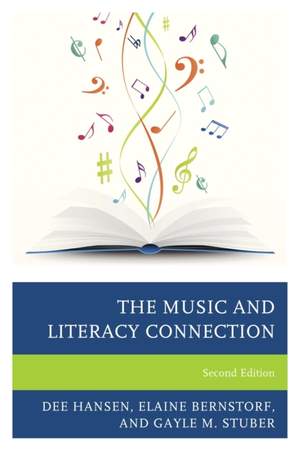The Music and Literacy Connection
- Author: Bernstorf, Elaine
- Author: Hansen, Dee
- Author: Stuber, Gayle M.
Pressure to improve student literacy skills has grown in this era of common core state standards (CCSS) and the Race to the Top initiative. Many administrators and specials teachers have sought... — More…
Book
$124.25Contents
- Foreword
- Preface
- Acknowledgments
- Introduction
- Chapter 1 The Threads of the Literacy Fabric: Foundation for The Music and Literacy Connection Creating a Common Vocabulary Decoding: Learning Musical Language and about Musical Language Implications of School-Reform Issues Implications for Music Educato
- Part I : Principle 1-Children are Interactive Learners.
- Chapter 2 Learning Language through Musical Play The Role of Play in Learning Theories of Child Development that Support Play Functional and Practice Play The Teacher's Role in Play and Literacy Development Language Learning through Play The Role of Musi
- Part II : Principle 2-Music Teachers are Literacy Teachers; Classroom Literacy Teachers are Music Teachers.
- Chapter 3 Music in the Reading Environment: Decoding Enhancing Reading Strategies Using Music Phonological Awareness Phonemic Awareness Rhyming Phonemic Awareness and Phonic Instruction Sight Identification Graphophonemic Awareness Cueing Systems Awarene
- Chapter 4 Reading in the Music Environment: Decoding Enhancing Music and Reading Strategies: Completing the Connection Loop Developing Specific Decoding Skills in the Music Classroom Exercises for Professional Learning
- Chapter 5 Music in the Reading Environment: Comprehension Acquiring Conceptual Understanding Curricular Integration Strategies Used Before Reading Questioning Strategies Teaching Conceptually Exercises for Professional Learning
- Chapter 6 Reading in the Music Environment: Comprehension Attention Working Memory Long Term Memory Comprehending Music Elements: Developing Conceptual Understanding of Music Inquiry the Music Classroom Modeling Building a Vocabulary Cooperative Learning
- Part III : Principle 3-Literacy Can Be Taught through Multiple Processes.
- Chapter 7 Considerations, Adaptations, Enhancements Music in the Reading Environment: Decoding Considerations Comprehension Considerations Enhancements through Media: Helpful or Hurtful for Comprehension? Reading in the Music Environment Decoding Conside
- Chapter 8 Common Connections: Skills and Concepts for Lifelong Learning Listening, Viewing and Speaking: Building Blocks for Language and Literacy Connecting Concepts with Skills: LVS Skills First? Create, Critically Think, Communicate, Collaborate Commo
- Chapter 9 Writing in the Music Classroom Writing Genres The Six-Trait Model of Writing The Six-Trait Model of Writing for Music Composition Other Writing in Music Class: Journaling Forms of Writing Writing for Developmentally Delayed Students Language an
- Part IV : Musical Training Provides Lifelong Benefits.
- Chapter 10 : Literacy Connections for Secondary Students (Brian Weidner, Contributing Author) Literacy Skills at the Secondary Level Decoding Higher-Order Thinking in Music at the Secondary Level Higher-Order Thinking and Executive Functioning 21st Centur
- Chapter 11 A Summary of Research Supporting the Benefits of Music Training Early Childhood: Play, Musical Experiences, and Musical Development Emergent Reading Development Language and Reading Acquisition Brain and Language Development Working Memory and
- Appendix I: Assessments of Literacy
- Appendix II: SMART Board Applications
- Appendix III: Cross-Disciplinary Literacy Examples
- Appendix IV: Analytic Scoring Guide for Evaluating Music Composition
- Bibliography




